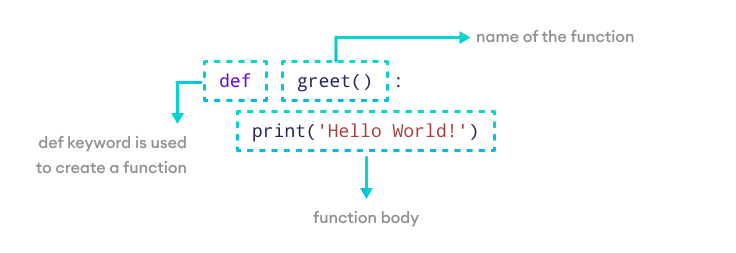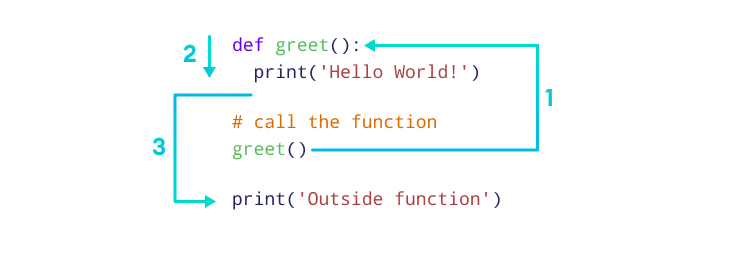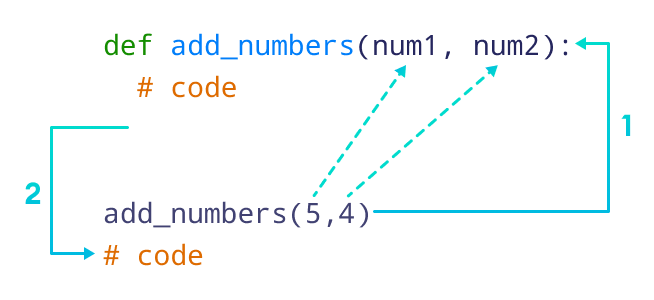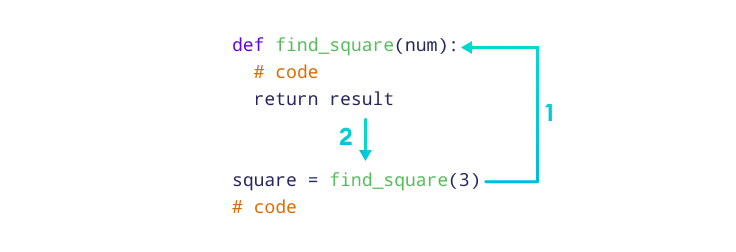A function is a block of code that performs a specific task.
Suppose we need to create a program to make a circle and color it. We can create two functions to solve this problem:
- function to create a circle
- function to color the shape
Dividing a complex problem into smaller chunks makes our program easy to understand and reuse.
Create a Function
Let's create our first function.
def greet():
print('Hello World!')
Here are the different parts of the program:

Here, we have created a simple function named greet() that prints Hello World!
Note: When writing a function, pay attention to indentation, which are the spaces at the start of a code line.
In the above code, the print() statement is indented to show it's part of the function body, distinguishing the function's definition from its body.
Calling a Function
In the above example, we have declared a function named greet().
def greet():
print('Hello World!')
If we run the above code, we won't get an output.
It's because creating a function doesn't mean we are executing the code inside it. It means the code is there for us to use if we want to.
To use this function, we need to call the function.
Function Call
greet()
Example: Python Function Call
def greet():
print('Hello World!')
# call the function
greet()
print('Outside function')
Output
Hello World! Outside function
In the above example, we have created a function named greet(). Here's how the control of the program flows:

Here,
- When the function
greet()is called, the program's control transfers to the function definition. - All the code inside the function is executed.
- The control of the program jumps to the next statement after the function call.
Python Function Arguments
Arguments are inputs given to the function.
def greet(name):
print("Hello", name)
# pass argument
greet("John")
Sample Output 1
Hello John
Here, we passed 'John' as an argument to the greet() function.
We can pass different arguments in each call, making the function re-usable and dynamic.
Let's call the function with a different argument.
greet("David")
Sample Output 2
Hello David
Example: Function to Add Two Numbers
# function with two arguments
def add_numbers(num1, num2):
sum = num1 + num2
print("Sum: ", sum)
# function call with two values
add_numbers(5, 4)
Output
Sum: 9
In the above example, we have created a function named add_numbers() with arguments: num1 and num2.

Parameters
Parameters are the variables listed inside the parentheses in the function definition. They act like placeholders for the data the function can accept when we call them.
Think of parameters as the blueprint that outlines what kind of information the function expects to receive.
def print_age(age): # age is a parameter
print(age)
In this example, the print_age() function takes age as its input. However, at this stage, the actual value is not specified.
The age parameter is just a placeholder waiting for a specific value to be provided when the function is called.
Arguments
Arguments are the actual values that we pass to the function when we call it.
Arguments replace the parameters when the function executes.
print_age(25) # 25 is an argument
Here, during the function call, the argument 25 is passed to the function.
The return Statement
We return a value from the function using the return statement.
# function definition
def find_square(num):
result = num * num
return result
# function call
square = find_square(3)
print('Square:', square)
Output
Square: 9
In the above example, we have created a function named find_square(). The function accepts a number and returns the square of the number.

Note: The return statement also denotes that the function has ended. Any code after return is not executed.
The pass Statement
The pass statement serves as a placeholder for future code, preventing errors from empty code blocks.
It's typically used where code is planned but has yet to be written.
def future_function():
pass
# this will execute without any action or error
future_function()
Note: To learn more, visit Python Pass Statement.
Python Library Functions
Python provides some built-in functions that can be directly used in our program.
We don't need to create the function, we just need to call them.
Some Python library functions are:
- print() - prints the string inside the quotation marks
sqrt()- returns the square root of a number- pow() - returns the power of a number
These library functions are defined inside the module. And to use them, we must include the module inside our program.
For example, sqrt() is defined inside the math module.
Note: To learn more about library functions, please visit Python Library Functions.
Example: Python Library Function
import math
# sqrt computes the square root
square_root = math.sqrt(4)
print("Square Root of 4 is",square_root)
# pow() comptes the power
power = pow(2, 3)
print("2 to the power 3 is",power)
Output
Square Root of 4 is 2.0 2 to the power 3 is 8
Here, we imported a math module to use the library functions sqrt() and pow().
More on Python Functions
In Python, functions are divided into two categories: user-defined functions and standard library functions. These two differ in several ways:
User-Defined Functions
These are the functions we create ourselves. They're like our custom tools, designed for specific tasks we have in mind.
They're not part of Python's standard toolbox, which means we have the freedom to tailor them exactly to our needs, adding a personal touch to our code.
Standard Library Functions
Think of these as Python's pre-packaged gifts. They come built-in with Python, ready to use.
These functions cover a wide range of common tasks such as mathematics, file operations, working with strings, etc.
They've been tried and tested by the Python community, ensuring efficiency and reliability.
Python allows functions to have default argument values. Default arguments are used when no explicit values are passed to these parameters during a function call.
Let's look at an example.
def greet(name, message="Hello"):
print(message, name)
# calling function with both arguments
greet("Alice", "Good Morning")
# calling function with only one argument
greet("Bob")
Output
Good Morning Alice Hello Bob
Here, message has the default value of Hello. When greet() is called with only one argument, message uses its default value.
Note: To learn more about default arguments in a function, please visit Python Function Arguments.
*args and **kwargs in Functions
We can handle an arbitrary number of arguments using special symbols *args and **kwargs.
*args in Functions
Using *args allows a function to take any number of positional arguments.
# function to sum any number of arguments
def add_all(*numbers):
return sum(numbers)
# pass any number of arguments
print(add_all(1, 2, 3, 4))
Output
10
*kwargs in Functions
Using **kwargs allows the function to accept any number of keyword arguments.
# function to print keyword arguments
def greet(**words):
for key, value in words.items():
print(f"{key}: {value}")
# pass any number of keyword arguments
greet(name="John", greeting="Hello")
Output
name: John greeting: Hello
To learn more, visit Python *args and **kwargs.
Also Read: